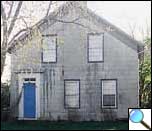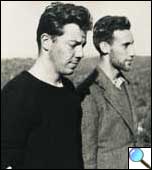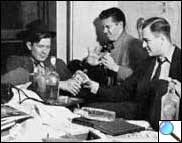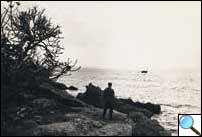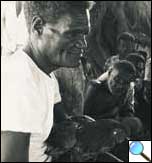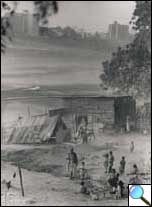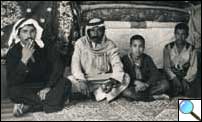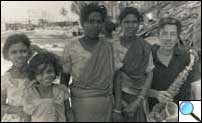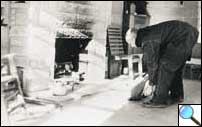 |
 |
 |
 |
|
FEATURE Edward Rice '40 was born on October 23, 1918, on the kitchen table of the Rice family home in Brooklyn, delivered by one Dr. Joseph McLaughlin, whose death in a shootout over a woman later made headlines. It's a good story. It may even be true. It is unquestionably closer to fact than the information Rice provided for his official class portrait in the 1940 Columbian. There, beneath the photo of a handsome young man wearing an expression of urbane amusement, Edward Rice's address is given as Cannes, France - a nice farewell fillip from the editor-in-chief of the irreverent Jester. Since then, Rice probably has covered more ground - intellectual, artistic and geographic - than any 10 of his Columbia classmates, even if you count the extraordinary circle of creative nonconformists who were his friends. He has written more than 20 books, including Captain Sir Richard Francis Burton, a best-selling 1990 biography of the famous 19th-century explorer, and hundreds of magazine articles. In 1953, he founded the groundbreaking ecumenical magazine Jubilee, which he kept going for 14 years. After he sold it in 1967, Rice traveled the world as a freelance photojournalist and writer for the next 20 years, returning with hundreds of black and white images - "Ed's wonderful, smoldering photos," as one admirer described them. Through it all, Rice has continued to paint, though it was only recently that he was persuaded to show and sell some of his work for the first time. As an octogenarian, housebound by advanced Parkinson's disease and impaired by poor eyesight, he seemed an unlikely recruit in 1999 to the ranks of "emerging artist," but the sale was a success and he is planning another. He is also putting together a book of his favorite photographs, and a collection of recipes and remarks tentatively titled Blind Ed's Bread Book is on the back burner. This, he says, is the way he has always worked, keeping multiple projects afloat, moving from one to the other. Only now the Parkinson's has imposed its harsh constraints on his ability to work and he doesn't hide his frustration. "Parkinson's is a dreadful disease," he says. "People just survive."
In the 1805 farmhouse on eastern Long Island that has been his home since 1974, Rice does his work in a room crammed to the rafters with the creative output of a lifetime - paintings, photographs, books, manuscripts, documents and a prized set of bound copies of Jubilee. With him are his ebullient Trinidadian housekeeper, Dolly, and his cat, Bigfoot. Like its owner, the house, built by wandering craftsmen who had come to Long Island from Maine, has a peripatetic past - a past that its time-worn exterior flaunts in defiance of its snooty surroundings in the chic little hamlet of Sagaponack. According to Rice, the house already had been moved several times when he bought it for under $10,000 and arranged to have it transplanted onto property he owned a short distance away. House-movers have always done a brisk business in this flatland, where the sight of a house crossing a field on slides or even afloat is not as startling as it might be elsewhere. The dust from the move had barely settled when Rice took off for the South Pacific. When he returned, weeks later, it was to a home that had landed in the right place but had not settled in. It was drafty, unheated, and he says he hated it then, though now it is warm and cheerful, filled with artifacts from his travels. On the walls are paintings from his series of icon- influenced robed saints in brilliant colors along with a selection of more somber portraits based on old family photographs. From the very beginning, Rice says he wanted to be an artist, but from the very beginning there were obstacles. His parents, well to do, Catholic, strait-laced and rigid in their ideas about social status and financial security, took a dim view of artists. Rice's mother, in particular, was determined that he become a doctor and, after sending him to a Quaker elementary school and Brooklyn's Poly Prep, her plan was for him to take a pre-med course in college. He was accepted at Harvard as well as Columbia. "The only reason I didn't go," Rice says of Harvard, "is because my parents wanted me nearby so they could keep an eye on me. They were afraid I was going to become an artist." So in 1936, dutifully but providentially, Rice entered the freshman class at Columbia, where the first thing he did was comb the catalog for art courses and sign up on the sly for life drawing. Then, after he had been at Columbia for only a few months, Rice's mother died of appendicitis. So he dropped all pretense of following the path she had laid out for him and, in fact, more or less stopped taking orders from anyone. Liberated from the lab, he entered the orbit of a group of campus bohemians whose chief members, Thomas Merton '38 (a campus big shot at the time, not yet a spiritual icon nor even a Catholic) and poet Robert Lax '38, became his closest friends. In his 1970 book, The Man in the Sycamore Tree: The Good Times and Hard Life of Thomas Merton, Rice recalls their first encounter: "One day, after I first began to submit drawings to Jester, amid all the confusion of the fourth floor [of John Jay Hall], I heard an incredible, noisy, barrel-house blues piano drowning out everything else (my first impression of Merton was that he was the noisiest bastard I had ever met), like four men playing at once." From then on they were friends, never losing track of each other, and today, more than 30 years after Merton's death, "not a day goes by that I don't think of him," says Rice.
Of the three friends, Merton was decidedly the loudest, the most authoritative, the most self-assured. Rice found him "full of energy," forever "cracking jokes, denouncing the Fascists, squares, being violently active, writing, drawing, involved in everything." Photographs in Rice's book show Merton looking boyish despite his businessman's garb (three-piece suit, watch chain, the works) and his already receding hairline. Lax was tall, lanky, long-faced and awkward, a strong if ethereal presence whose mystical ruminations and verbal zaniness baffled, charmed and were always assumed to reflect something deep. Known for his lofty tastes and extreme asceticism, he was also socially agile, constantly introducing his old friends to new friends and widening the circle of which he was the center. One summer he invited Merton and Rice to spend the long vacation at his family's cottage in upstate Olean, N.Y. The next summer more friends were invited, women were thrown into the mix, and the chaotic commune they created at Olean prompted Lax's sister to declare them "the first hippies." Lax was contradictory, elusive, easy to love but hard to know; even Rice, who was his good friend and kept in contact over the years, concedes defeat. Lax left the New York magazine world in 1964 and eventually settled on the Aegean island of Patmos, where he wrote poetry up until his death last September. "I don't think I'll ever figure out what was going on in Lax's head," Rice says. Rice, the youngest of the three, first got the others' attention with the clever drawings he brought to Jester, then quickly became the third man in the troika. "They were the three musketeers," recalls the publisher Robert Giroux '36. "They were good pals, highly sophisticated, with good senses of humor and very artistic." Giroux was slightly older, but he knew them, admired them and kept in touch. In 1948, when he was a young editor at Harcourt, Brace, Giroux recommended publication of The Seven Storey Mountain, Merton's very personal account of his progress from reckless youth to Trappist monk (Merton had entered the Abbey at Gethsemani in Kentucky in 1941). A spectacular publishing success, the book, which gets credit for humanizing the Catholic message and creating a rush on the church (as well as a cash coup for the monastery, which collected the profits), also includes some vivid descriptions of the hard-drinking, jazz-loving, movie-crazed, soul-searching, fiercely competitive bunch who hung out in the noisy nerve center of student activities at Columbia and forged lasting friendships. The fourth floor of John Jay was "constantly seething with the exchange of insults from office to office," wrote Merton. If they weren't writing articles or drawing cartoons, its habitués were "calling one another up on the phone and assuring one another in the coarsest of terms of their undying hatred." If, despite the constant combat, it was the place everyone wanted to be, Merton thought that was because the strife was "all intellectual and verbal, as vicious as it could be, but it never became concrete, never descended into physical rage." It was, he believed, "all more or less of a game which everybody played for purposes that were remotely esthetic."
Among those who could usually be found there, in addition to Rice, Lax and Merton, were Seymour Freedgood '48, later an editor at Fortune, whose suavity and gift for clever extemporaneous lying seems to have kept his friends confused and amused; Bob Gibney '36, whose humor was mined from a darker, edgier vein; and Bob Gerdy '39, Rice's predecessor as editor of Jester, a future New Yorker editor, and a man whom Rice describes as "one of the smartest people I ever met in my life." Ralph de Toledano '38, managing editor of Jester in 1937-38, the year Lax was editor and Merton art editor, was also on the scene, as was Eugene Williams '39, whose Greenwich Village apartment was the place they all went to hear jazz, meet musicians and avoid going to class. The painter Ad Reinhardt '35, who had earlier impressed everyone with his Jester layouts and cover designs, had graduated and moved on, though he maintained his friendship with Lax and spent a summer at Olean. Rice thrived amidst such creative chaos, and when he won a fiercely contested fight for the coveted editorship of Jester in his final year, he had future New Yorker cartoonist Chuck Saxon '40 doing covers and cartoons; Jim Knight '40, later news editor of the Paris edition of The New York Herald Tribune, as his most productive and versatile writer; and "other characters, real and apocryphal," writing, drawing and handling the business side of the enterprise. He also had Merton, Lax and Gerdy back in "the boiler room," even though all three had graduated. Gerdy helped with layout and wrote stories. Lax submitted an interminable tale titled "Enchanted Palace," which came out in installments. Merton contributed writing and drawings, including a notorious series of bearded ladies in the buff who cavorted across several pages of the February 1940 edition, confusing the grinds, offending the good boys and riling the authorities - which, of course, was the point. Rice put it all together and wrote under various names with the glib recklessness that was de rigueur. Everyone was reading Joyce, recalls Rice. Lax, whose judgment on such matters was regarded as the last word, had pronounced Joyce the only author worth reading, and the Joycean esthetic was all-pervasive. "Everything was influenced by Joyce," Rice says, "down to our clothing - the necktie, the tweed jacket - and we imitated his way of writing." If Joyce was their literary hero, jazz was their music. Everyone listened to recordings by Bessie Smith, Louis Armstrong, King Oliver, Bix Beiderbecke. They frequented jazz joints and stole time from their studies to steep themselves in the jazzy atmosphere of Gene Williams's hip Village salon. When Williams brought trumpeter Bunk Johnson up from New Orleans, they all went to the Stuyvesant Casino to hear him. If nothing special was on, Nick's on Sheridan Square was usually rocking with jazz, or there was a party somewhere with enough booze, weed and women to keep the wild anti-establishment ethos alive. In The Man in the Sycamore Tree, Rice captured the restlessness and uncertainty of the times in a passage typical of what one critic called his "kaleidoscopic recollections" - fast-paced, present-tense verbal impressions that give the book its remarkable immediacy and richness: "World War II has started," he wrote, "the depression is not yet over and the future is unpromising. There is a lot of heavy drinking and parties that never seem to stop, rushing about in cars and trains and buses. There is also a lot of talk about marijuana, which is called muggles, reefer, tea, charge, mezz, eagle dust, gauge, mary jane and Mary warner, stick and weed ('A friend with weed is a friend indeed')."
Beneath the horseplay, there was something else. Rice remembers that they read Look Homeward Angel and sent postcards to each other with the message, "O lost!" They flirted with despair even as they explored alternatives. Some, including Merton momentarily, thought they had found the answer in far left politics, though Rice never bought into it. A surprising number of his friends were toying with the idea of becoming Catholics, a path Merton already had embarked upon though few around him realized how far he had progressed. Rice was a Catholic from childhood (though he has never hesitated to question the Church or his relationship to it, and once left the Church entirely for more than a decade), but was no less involved in the spiritual explorations going on around him. In 1938, Seymour Freedgood brought the Hindu monk, Bramachari, to Columbia, where he and Lax harbored him for weeks in their Furnald Hall room. This was strictly against the rules, but possible, according to Rice, because the little monk "made himself invisible when the cleaning women came into the room." Unassuming (apparently to the point of invisibility if necessary), Bramachari nevertheless exerted a powerful influence on Merton, the only one who was ripe for his low-key spiritual message, according to Rice, who noted that the rest of them were still dabbling in "half-baked mysticism," and too committed to worldly involvement to respond. Rice says he was surprised when he heard that Merton had decided to convert to Catholicism and wanted him to be his godfather. At the time, he thought Merton was "crazy," but maintained that he really had no "strong opinions one way or the other." On November 16, 1938, the baptism took place with Rice as godfather and Lax, Gerdy and Freedgood (all Jews as it happened) as witnesses. Of the three, Lax and Gerdy later followed Merton into the church; Freedgood did not. Rice's account in The Man in the Sycamore Tree of the following summer, when he and Merton joined Lax at Olean, offers no evidence of religiously inspired restraint. The three grew competing beards and raced to see who could finish a novel first. Rice was the hands-down winner of the writing race, wrapping up The Blue Horse - 150 pages long and illustrated - in a cool 10 days, but he was badly beaten in the beard contest. His was scraggly. Of the mood that summer, Rice wrote: "Life is simple but there is an interior tension, as if we are trying to break out of something. We are, but are unable to formulate it. We drink, go to Bradford where we are cleaned out by a confidence man at a carnival, pick up girls from the TB sanitarium down the road, drink, get arrested." The food is so abominable that Merton hurls the hamburgers, one by one, over the roof of the house, then moves on to the peas. The next summer was the same, only more so - more people, more restless road trips, more bad food, more drunkenness. For Rice it was too much of a good thing, and he retreated to New York. By the next summer everyone had dispersed, but most had been so thoroughly formed by the up-for-anything, antiestablishment spirit of their Columbia years that it stuck with them for life. Rice took a low-level job in advertising, then went on to work at various publications, to make newsreels and documentaries, and to serve as publicity director at RKO-Pathe. Merton entered the monastery in 1941. Gerdy, Knight and Freedgood all went to war. Lax, who had taken a job with The New Yorker, left it after a year and was teaching in North Carolina when a letter from Rice put an end to his prolonged state of spiritual indecision. Responding to Rice's suggestion that he come to New York and get baptized, Lax got on a train and the baptism took place on December 19, 1943.
By the time Rice was ready in 1953 to act on a long-held ambition to start his own magazine, he had married and was living in New York with his wife Margery and their son, born in 1951 (a second son was born in 1954). Jubilee was conceived as "a Catholic magazine with a pictorial format and a commitment to the Church's social teachings," as Rice put it in a Spring 1999 contribution to the quarterly review, The Merton Seasonal. The piece, titled "Starting a Magazine: A Guide for the Courageous - The Short Happy Life of Jubilee," is preceded by an Editor's Note, which calls Jubilee "a significant force in the awakening of the American Catholic Church to the wide world in the post-war and Vatican II period." It begins with Rice's description of his unsuccessful efforts to persuade rich Catholics to invest in the new magazine, an unpleasant and ultimately futile exercise that could only have confirmed him in his longstanding wariness towards the establishment. (Joseph Kennedy told him, "I never encourage the young;" Clare Booth Luce suggested he channel his talents into Life and "make it a better magazine.") Realizing he was wasting his time, Rice developed a plan to bypass the capitalists by selling stock to subscribers and staff. Preferred stock was offered at $100 a package (20 shares and a lifetime subscription); $5 stock packages (a $1 share and a one-year subscription) were also available. In six months Rice had raised $35,000 and was ready to go with a staff comprised of old friends (Lax, ever hard to pin down, was named "roving editor," and Merton wrote more than two dozen articles over the years), some new ones, and an energetic group of volunteers who came to the Jubilee offices on Wednesday evenings to help with mailings and type manuscripts. Wilfrid Sheed, the British-born author who eventually wrote book and movie reviews as well as articles for Jubilee, was living abroad when the first issues came out in 1953 but remembers a friend excitedly describing the new magazine to him when he got back. The layouts broke rules in highly imaginative ways, the photographs (many of them Rice's) were much admired, and Rice set no boundaries on subject matter. Readers might find a piece on the Desert Fathers next to a cut-out for children, a photo essay on a Greek monastery, a movie review, a report on Apartheid or an expose of sleaziness in the funeral industry.
"Rice was introducing Catholics to other cultures so they wouldn't be so parochial," says Sheed. At a time when it was assumed that Catholics were interested in Bing Crosby and football and not much else, Sheed recalls that "Jubilee was bringing in the Far East, liturgical art - things that then became part of the vocabulary of every Catholic, or at least those with an interest in the life of the mind." "People of taste gravitated toward Jubilee," agrees Giroux. "It was a beautifully edited magazine." By all accounts, it was also a lot of fun for the people who worked on it. Sheed remembers Jubilee's loft headquarters on Park Avenue South as a kind of anti-office where the tone was set by Rice's old gang from Columbia ("Beatniks but with some kind of purpose to them," as Sheed puts it, "the Catholic answer to the Beatniks"). Reinhardt dropped by with funny drawings. Mother Teresa made Jubilee her first stop when she came to America. Jack Kerouac '44 came with his jug of Muscat and some religious poetry to submit. There were young writers like Sheed and Richard Gilman getting their start, and a flock of volunteers and job-seekers who were excited by the concept, fascinated by the people Rice and Lax pulled into their orbit, and eager to be part of it. Gilman, who recalled his Jubilee days in his 1986 memoir, Faith Sex Mystery, wrote that he was excited by "the sense of purpose" he found there, "by the asceticism nearly everyone preached and more or less practiced." Later, he came to think that there was something "almost painfully touching" about the trust he and others at Jubilee "seemed to have in the Church as an (eventual) agency of moral and social change." To Sheed, it seemed that there was "a kind of Early Christian sense of everybody being everybody's friend, of all being in this together, even the husbands of volunteers. It was very exciting." As roving editor, Lax showed up "when he good and felt like it," according to Sheed, and vanished periodically "on his own mysterious imperatives." Rice had no problem with the freewheeling atmosphere in the office - helped to create it, in fact - but at the same time, he was putting in 12-hour days doing the jobs of editor, managing editor, art editor and production editor. Oona Sullivan, who arrived as a volunteer and eventually lightened the burden for him as associate editor, then managing editor, says simply, "Jubilee was Ed Rice."
"He had this marvelous genius," says Sullivan, "pictorially, editorially - you could bring a story in to him and before you were out the door, he'd say, 'Okay, go ahead.'" For young writers this was heady stuff. Sullivan was let loose on a tough drugs-in-the-streets story she might have waited 10 years to tackle for a more cautious editor, and came up with an impressive piece titled "Hooked on Horse." Artist and designer Emil Antonucci, who teaches now at the Parsons School of Design, got his start at Jubilee, and recalls that many others did, too. "He fostered so many talents," says Antonucci of Rice. "He was a brilliant editor, his antenna for ideas and things was so great. Jubilee was far ahead of its time, and it was his concept and handling that did it." Says Rice, "I gave everybody a chance. I was happy to see people coming in with picture stories or whatever. I never had enough material." The magazine was well received - Time, Newsweek and The New York Times all ran flattering stories on Jubilee and it won prizes every year - but money was always a problem; when Rice dared to invite discussion of issues like birth control and remarriage, it became even more of a problem. Subscriptions fell off and parish outlets were canceled. At about the same time that Rice was losing the battle with the bill collectors at Jubilee, his marriage also was collapsing, and in 1967 the end came for both. Rice sold Jubilee (which lasted only briefly without him), and prepared to distance himself from the city and a social life highlighted by dinner parties at his home on Waverly Place that live in Sheed's memory as impossibly dazzling affairs. To Sheed, Ed and Margery Rice seemed "the most glamorous couple I had ever seen."
That Rice then turned to photojournalism to make his living seems an odd choice for a man who was born with a congenital coloboma that prevents his right eye from focusing. In his case, however, the handicap proved an advantage. "Cameras are made for right-eyed people," says Rice, "so all my work was carried out with one eye blind and the other, the left, hidden by the body and the lens of the camera, which - so I have been told - produces a kind of 'other worldly' interpretation of otherwise mundane scenes." These are the extraordinary images piled high in the front room of the farmhouse, taken on assignment for periodicals, the United Nations, the World Health Organization, or sometimes on his own initiative. If there was something Rice was interested in, he went to the site, then found assignments to pay his expenses. For his book about the cargo cults in the South Sea Islands, John Frum He Come, published in 1970, Rice traveled to the island of Tanna. Merton also had been intensely interested in the strange mystical faith whose adherents believed that one day years of colonial exploitation would end with the coming of a white messiah who would perish, leaving his cargo of goods from white culture behind. Merton and Rice had talked about pursuing the subject together, but in 1968 Merton was electrocuted in a bizarre accident while attending a conference in Bangkok; Rice was obliged to follow through on his own. Fiercely anti-colonial, John Frum He Come was praised in the New Yorker as "a quite wonderful book, written by a man who, although a conscientious reporter and researcher, makes no pretension to scholarship or, above all, to objectivity. He is angry at the callous and persisting exploitation of the native people of the South Pacific - at the theft of their lands by white men, their virtual economic enslavement, the stamping out of their ancient cultures."
Rice's Burton biography, hailed as "a masterpiece" by the Los Angeles Times, "first class" by The New York Times, and "the last great word on the last great explorer" by the Wall Street Journal, was written after 10 lengthy journeys to India, Pakistan, Nepal, Iran, the Arab countries and Israel. Along the way, Rice took risks, and sometimes suffered the consequences. "I always wanted to do the daring thing," says Rice, and notwithstanding the evident self-mockery, there is reason to believe it is true. He has hair-raising tales. Perhaps his most chilling, an incident that still gives him nightmares, occurred when Bedouins in Jordan, furious because he had violated a ban on photographing women, decided to disembowel him on the spot. Only after he had argued with them for hours, yanked the film from his camera and stomped on it, did his captors agree to release him and his traveling party. When his sight deteriorated to the point where he could no longer function as a photographer, he had eight or 10 writing projects to turn to. When a decade ago he met and married Susanna Franklin, whose mother was an American Indian, he had a partner who shared his interests and became his collaborator. Then, after they had had only a few years together, Susanna was killed in an automobile accident. The blow aggravated the Parkinson's, and for a while, Rice says, he lost interest in just about everything. It has taken a long time, but the projects are back on the table. A tentative selection of the photographs he wants to put in a book has been made, and there is some text to go with them, though he is not satisfied with it yet. The next show and sale of his paintings in Sagaponack (at the Farmhouse Gallery, as it is to be known for the occasion) will take place in July. Recently, the director of the Thomas Merton Center in Louisville wrote to ask if Rice had any paintings for sale. In going through Merton's hermitage at Gethsemani, he had been struck by an oil on wood - one from Rice's series of saints - that was still on the wall where Merton had hung it. About the Author: Mary Cummings is a freelance journalist and author of the Images of America illustrated history, Southampton. She lives and works on eastern Long Island, not far from Edward Rice.
|
|
|||||||||||||||||||||||||||||||||||||||||||||||||||||||||||||||||||||||
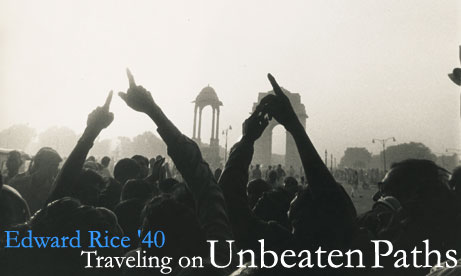 Breaking rules and taking risks as a writer, publisher,
artist and photojournalist
Breaking rules and taking risks as a writer, publisher,
artist and photojournalist